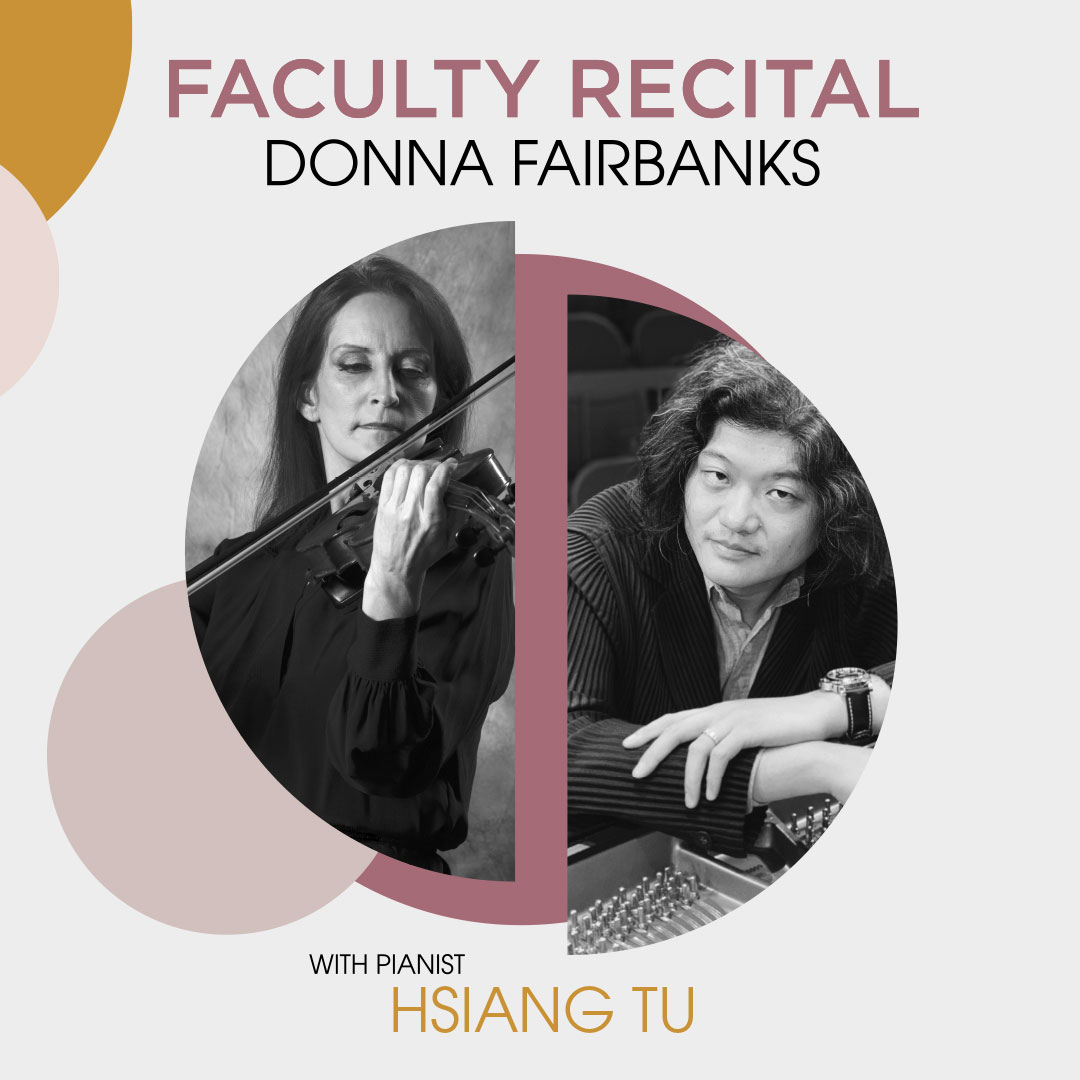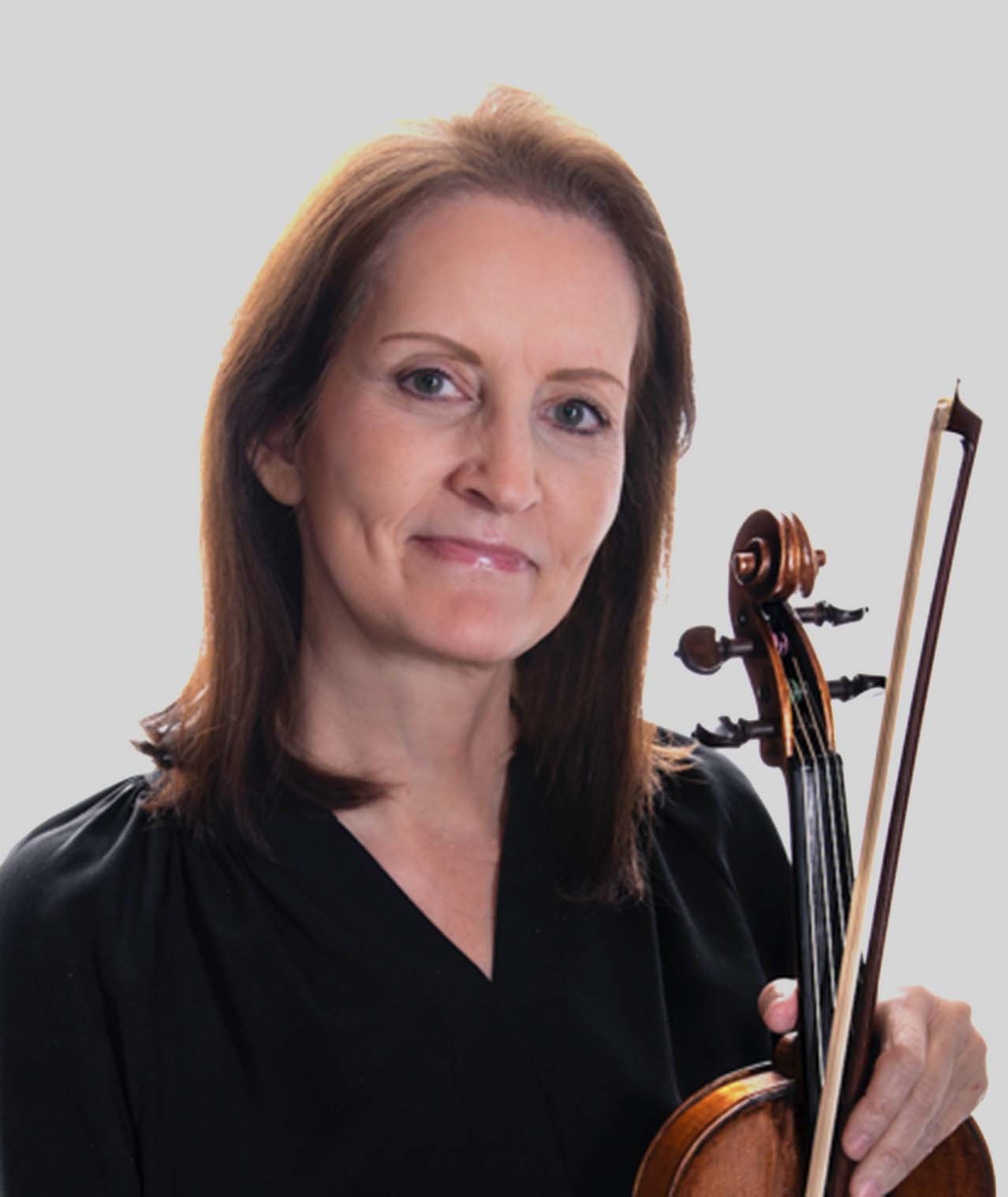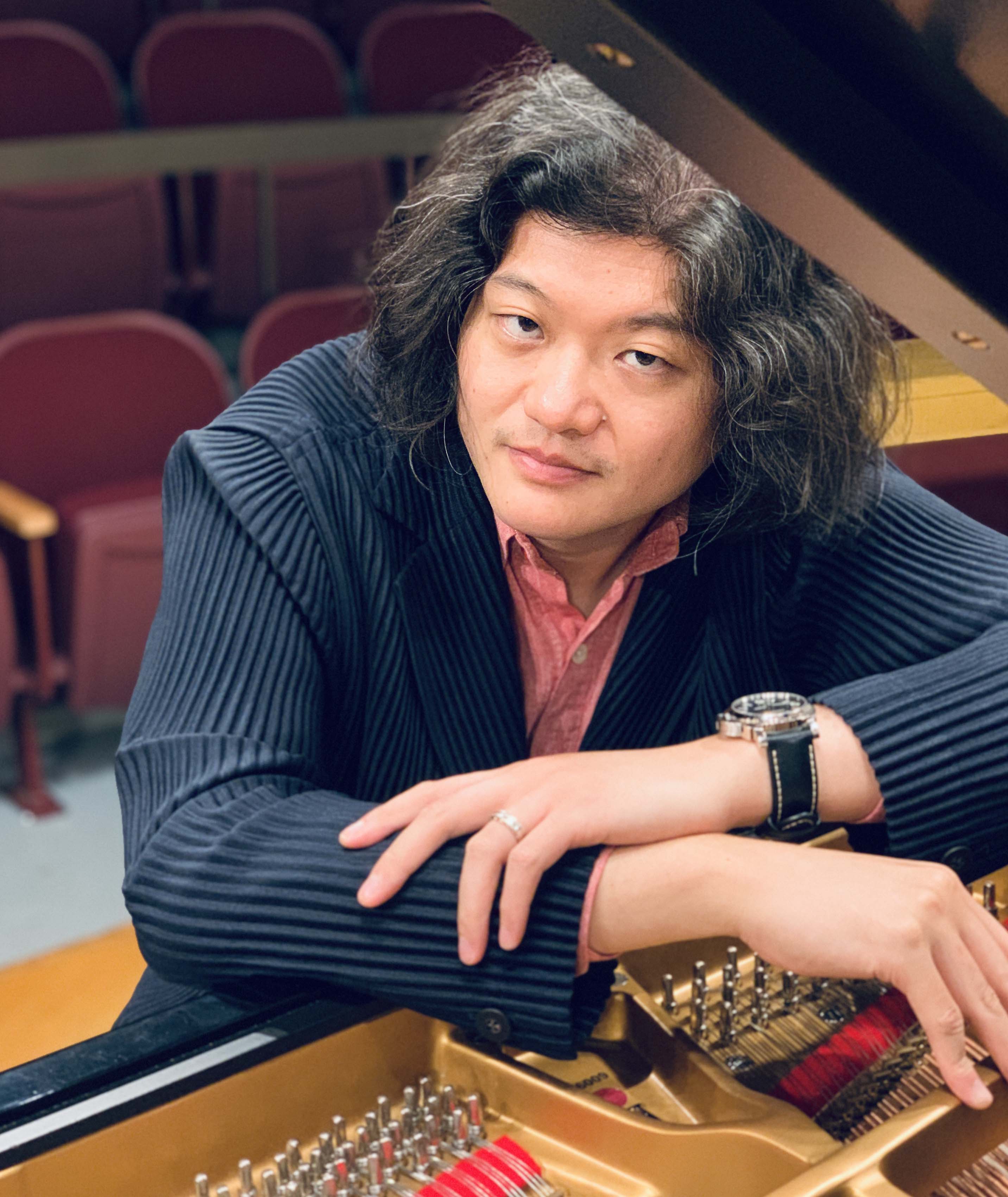
Donna Fairbanks, violin
with
Hsiang Tu, piano
January 31, 2022 | 7:00 PM
Sonata in B-flat major, K. 454 (1784)
Wolfgang Amadeus Mozart (1756–1791)
I. Largo – Allegro
II. Andante
III. Allegretto
Sonata in C major (1939)
Paul Hindemith (1895–1963)
I. Lebhaft
II. Langsam – Lebhaftt
III. Fuge: Ruhig bewegt
[SHORT INTERMISSION ]
Recitativo and Scherzo, Op. 6 (1911)
Fritz Kreisler (1875–1962)
Sonata in A major (1886)
César Franck (1822–1890)
I. Allegretto ben moderato
II. Allegro
III. Recitativo–Fantasia
IV. Allegretto poco mosso
Some of Mozart’s earliest works, written between the ages of 6 and 8, are written for the keyboard and violin. Notably, these works incorporated a number of “firsts” for Mozart: his first writing for the violin, writing for more than one instrument, multi-movements, and sonata form. His more mature sonatas for keyboard and violin, which he began at the age 22, he designated as Oeurve premier (new work), essentially relegating the sonatas he composed as a child as non-important or a separate category altogether. These mature sonatas hold historical significance, as they are the first works written by a major composer for violin and keyboard that exhibit equality between the two instruments: a true duo. Composers following Mozart would continue this legacy, culminating in a great breadth of chamber music for the violin and piano. Mozart’s sonata in B-flat major, K. 454, was part of a later group of sonatas he composed while living in Vienna. Consistent with his other mature sonatas, there is a true sharing of thematic material between the violin and piano, alternating turns or playing in unison. The work was written for the virtuoso violinist Regina Strinasacchi, and was premiered on April 29, 1784, by Strinasacchi along with Mozart performing keyboard. Mozart had not yet written out the piano part, so he performed with blank sheet music, much to the amusement of Emperor Joseph II who was in the audience. Mozart’s genius is on full display with this work. There is sophistication, including some bold modulations in the first movement, combined with healthy dashes of playfulness.
A child prodigy violinist, Fritz Kreisler entered the Vienna Conservatory at the age of seven. He entered the Paris Conservatory three years later, and at the age of twelve he won the Premier Grand Prix de Rome gold medal in competition with forty other players. One year later he gave a recital tour of the United States with pianist Moriz Rosenthal. After his one-year tour, he returned to Vienna to audition for the Vienna Philharmonic. When he did not win the audition, his disappointment lead to disillusionment, and he left music altogether for about nine years, spending time studying medicine and then a brief period in the Austrian army. He returned to the violin in 1899, and a series of successful concert tours ultimately lead to international acclaim. Kreisler wrote a number of works for the violin, primary short pieces and cadenzas, many of which are established staples in the violin repertoire. His Recitativo and Scherzo for solo violin is the most virtuosic of his short compositions, displaying difficult techniques such as glissando octaves and double harmonics.
Paul Hindemith was versatile with the performance of numerous instruments, but the violin was his initial primary discipline. His notorious skill on the violin landed him a concertmaster position with the Frankfurt Opera Orchestra at the young age of nineteen. Following World War I, Hindemith was drawn increasingly towards the viola. In 1921 he founded the Amar Quartet, playing the viola, and became dedicated to the performance of contemporary chamber music. Even with a focus on viola, Hindemith continued to perform and write for the violin. His series of sonatas for violin, some written with piano and others unaccompanied, demonstrate an impressive breadth of violin technique and represent the evolutionary stages of Hindemith’s compositional style. Written in 1939, his Sonata in C major is his fourth and final sonata written for violin and piano. It reflects Hindemith’s usage of contrapuntal technique and includes fugal sections in the second and third movements.
César Franck’s Violin Sonata in A major (1886) is considered one of his most significant works, composed during an especially prolific period during the last few years of his life. The sonata is infamous for its cyclical structure, a compositional style in which material from previous movements is pulled into subsequent movements. The introductory two-measure motive played by the violin serves as a building block for all the main themes within the sonata. It was this skillful use of motivic development that created such fervor within Franck’s circle of pupils, legitimizing in their eyes Franck’s role as Beethoven’s successor. Franck dedicated the work to the famous Belgian violinist Eugène Ysaÿe (1858-1931), and the sonata was delivered in autograph form as a gift at Ysaÿe’s wedding. Ysaÿe sightread the sonata during his wedding festivities, and subsequently became an enthusiastic promoter of this work. Recognizing the significant challenge of the piano part, he stated in a letter to Franck: “I shall play this masterpiece everywhere that I find a pianist who is also an artist.”

As a recording artist, violinist Donna Fairbanks has released several published CDs with labels such as Albany Records, MSR Classics, 4TAY Records, and Tantara Records. Her list of recorded repertoire include notoriously difficult works such as Lou Harrison’s Concerto for Violin and Percussion and Arvo Pärt’s Fratres, as well as classic masterpieces such Camille Saint-Saëns’ Fantasie for violin and harp. Reviewers praise her “great precision” (Fanfare), “delicacy and fire” (Grammophone), and describe her performances as “very convincing and pristine” (ConcertoNet), with “plenty of melodic beauty” (Atlanta Audio Club). Her recordings have been featured on major public radio stations and networks, among them WNYC New York City, WFMT Chicago, WPRB Princeton, WQED Pittsburgh, WSHU Connecticut, WFSU Florida, the Minnesota and Wisconsin Public Radio Networks, and the Beethoven Satellite Network.
Donna’s international recital career includes performances in China, Brazil, Mexico, and Europe. Notable venues include the Gent Festival in Belgium, Schumann Festival in Germany, Rotterdam Conservatory, Hungarian National Gallery, Teatro Ouro Verde in Brazil, and the Nanjing, Shanxi, and Huazhong Universities in China. She has completed faculty residencies at Universidade Estadual de Londrina in Brazil and the YouHao Art Center in Beijing, China.
Donna currently serves as Professor of Music and String Coordinator at Utah Valley University. She held previous faculty positions at Brigham Young University and the University of Minnesota’s MacPhail Center for the Arts. She received a Doctor of Musical Arts in Violin Performance from the University of Arizona, a Master of Music from the Eastman School of Music, and a Bachelor of Music from Brigham Young University, with additional conservatory studies at the University of Missouri Kansas City and the University of Cincinnati. Her teachers included Zvi Zeitlin, Varujan Kojian, Morris Hochberg, Tiberius Klausner, William Haroutonian, Percy Kalt, John Ferrell and John Lambros. She also received coachings from William Primrose, Joseph Silverstein, and members of the Cleveland Quartet.

Praised by The New York Times for his "eloquent sensitivity," The Boston Intelligencer for his "impeccable technique," and Fanfare for his “Chameleon-like ability to move between composers,” pianist Hsiang Tu has graced the audience with his thematic programs and broad range of repertoire. Dr. Tu is currently working on the complete cycle of piano solo works by Maurice Ravel and thematic recitals featuring animal-themed music. Born in Taipei, Taiwan, he debuted in New York at Alice Tully Hall in Lincoln Center as the winner of The Juilliard School Concerto Competition and has performed in venues all over the world, including the Museum of Modern Art in New York, Banff Centre for Arts and Creativity, National Museum Cardiff, and National Recital Hall in Taipei.
A prizewinner at the New Orleans International Piano Competition, the Iowa International Piano Competition, and the American Paderewski Piano Competition, Hsiang has appeared with the Calgary Philharmonic Orchestra, Louisiana Philharmonic Orchestra, Sioux City Symphony Orchestra, and the World Civic Orchestra, among others. He has given masterclasses throughout the U.S., including the University of Southern California, Penn State University, Peabody Conservatory Preparatory Division, and the University of Tennessee.
His debut solo CD, Bestiary on Ivory, has recently been released by Bridge Records. The American Record Guide enthusiastically wrote that “Hsiang Tu plays with verve and poetic intensity, giving each creature its artistic due.”
Hsiang recently completed a short residency as a Visiting Professor at the University of Taipei and released an educational outreach video, "The Ivory Menagerie," on YouTube in collaboration with the Gina Bachauer International Piano Foundation that features interviews, in both English and Chinese, and performances of music inspired by the animal kingdom.
Before being appointed as an Assistant Professor of Piano at Virginia Tech in 2019, Dr. Tu taught at the University of New Hampshire, Utah Valley University, and Snow College. He studied with Hung-Kuan Chen, Jerome Lowenthal, and HaeSun Paik, and holds a B.M. in Piano Performance from the University of Calgary and an M.M. and D.M.A. in Piano Performance from The Juilliard School. For more info, please visit hsiangtu.com.
Department Chair
JEFFREY O'FLYNN
Associate Chair
MELISSA HEATH
Administrative Assistant
CHRIS GINES
Choirs
REED CRIDDLE
CHERILYN WORTHEN
Orchestra/Cello
CHEUNG CHAU
Violin
DONNA FAIRBANKS
Clarinet
JEFFREY O’FLYNN
Trumpet/Music Theory
RYAN NIELSEN
Percussion
SHANE JONES
Piano
HILARY DEMSKE
Jazz/Commercial
DAVID BAKER
Voice
MELISSA HEATH
ISAAC HURTADO
Commercial Music
CHARLIE HAN
TODD SORENSEN
Theory
BRYCE RYTTING
Musicology
ROSS HAGEN
Director of Bands
CHRIS RAMOS